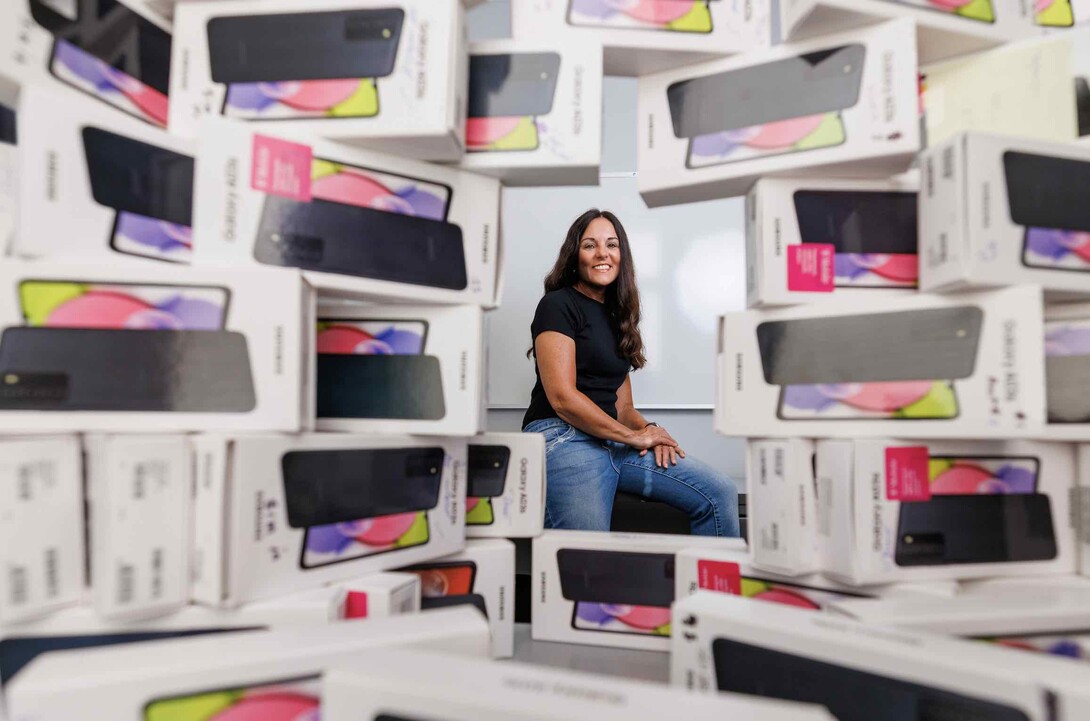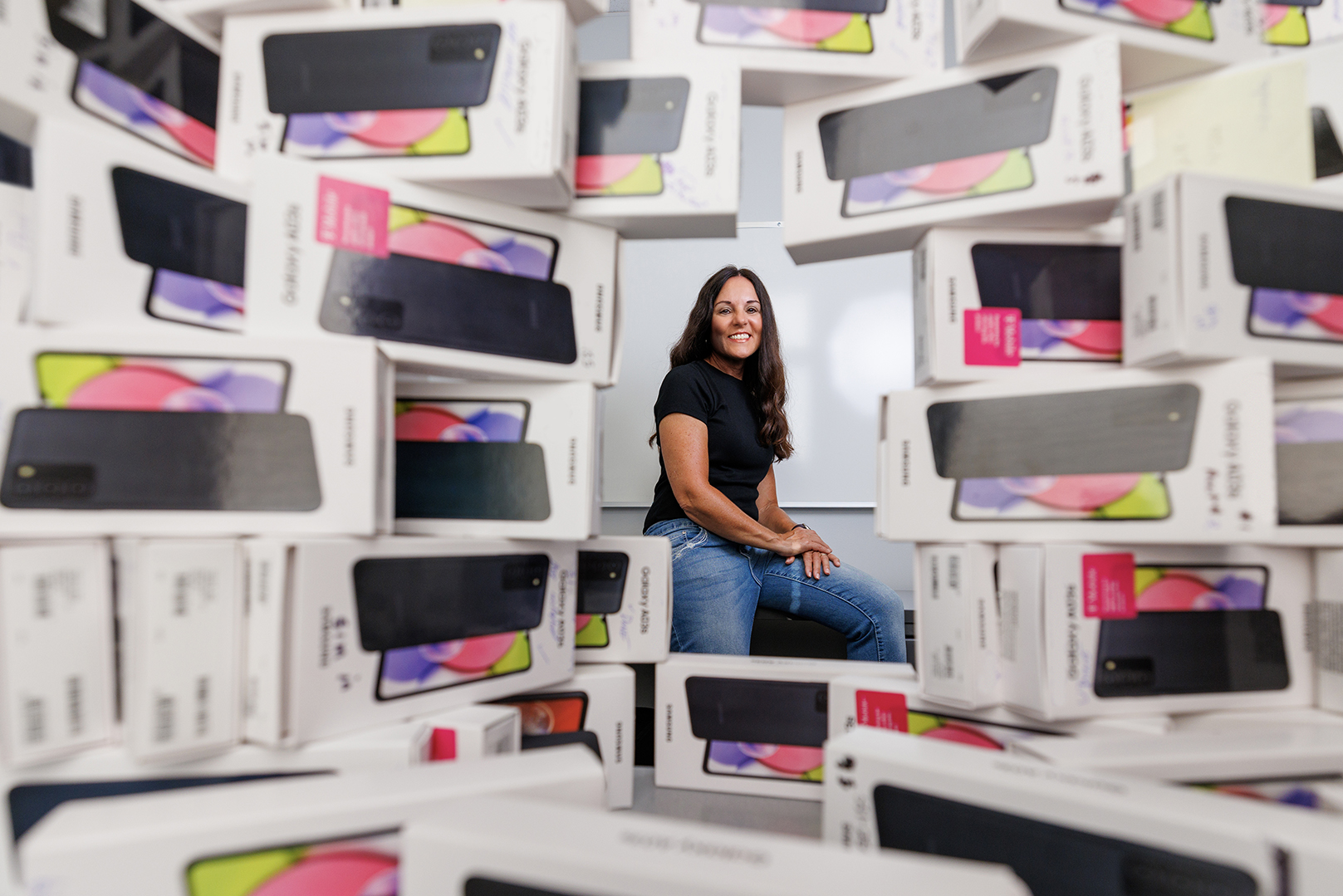
Back in 2017, Husker sociologist Kimberly Tyler was wrapping up a National Institutes of Health-funded pilot project that collected daily data on alcohol and drug use among youth experiencing homelessness via text message.
The project was successful, resulting in 11 publications and novel findings about collecting data from this hard-to-reach population. But for Tyler, the pilot also sparked a realization that paved the way for the next chapter of her research.
In post-study interviews, Tyler learned that cellphones — which she viewed primarily as an inexpensive device for data collection and tracking — meant much more to the participants. The youth said the phones served as a lifeline to other people, enabling supportive conversations that were not typically part of their day-to-day lives. Engagement with Tyler’s team provided an important boost.
“Just being asked about their day was revolutionary for some of them,” said Tyler, George Holmes University Professor of Sociology at the University of Nebraska–Lincoln. “It made them feel like someone cared about them. They don’t have a lot of support, and they just really crave that interaction.”
That realization — that communication via phone can provide critical support for youth experiencing homelessness — inspired Tyler to develop an idea that last year received a five-year, $3.4 million grant from the NIH–National Institute on Drug Abuse. She aims to develop a data-driven, app-based just-in-time intervention that provides individualized support at critical junctures where alcohol and drug use may be a tempting coping mechanism.
The larger goal is to mitigate substance misuse, which is two to three times more prevalent among youth experiencing homelessness than among their housed peers.
Tyler coined the approach a just-in-time personal support intervention. The idea is that youth experiencing homelessness may be more likely to misuse substances at certain moments: after sexual or physical victimization on the streets, in times of poor mental health, or while socializing with risky networks, for example. Through mathematical modeling and machine learning techniques, the app would be able to identify how likely an individual youth is to engage in substance use at a given moment and deliver supportive messaging to redirect them.
The intervention would be the first just-in-time platform for this population. Although there are apps through which youth experiencing homelessness can access information about various services, Tyler’s would be the first to proactively provide individualized content to these young people when they need it the most.
“Youth don’t have to look anything up — the app is going to be running on their phone all the time,” she said. “It will be a step beyond what we currently have in trying to intervene in these high-risk situations.”
The approach is economical and accessible, given the increasing prevalence of free, public WiFi hotspots and the decreasing cost of cellphones.
The intervention would also deliver general, proximity-based information about services. Tyler said agencies like Cedars Youth Services in Lincoln and Youth Emergency Services in Omaha report that one of their greatest struggles is getting the word out about programming. Youth experiencing homelessness often miss out on services like pizza parties, informational sessions about potential jobs and GEDs, financial counseling and beyond simply because they don’t know about them.
With the app, cellphone GPS tracking could detect when a youth is near a service center — and nudge them with relevant information.
“If kids can download this app to their phone and find out about things going on inside the agencies, that’s so impactful because they may never hear about these services otherwise,” Tyler said.
Right now, Tyler’s team is in the first phase of data collection from 150 youth, ages 17 to 24, in Lincoln, Omaha and Kansas City, who don’t have a permanent place to live. They’re doing surveys and other data collection through a software platform called the Open Dynamic Interaction Network, developed by project co-investigator and former Husker researcher Bilal Khan. They will use this information to make connections between youths’ daily stressors, emotional management and coping behaviors, especially alcohol and drug use.
Then, machine learning techniques will cluster this data to generate at least 150 different profiles. After downloading the app, a new user will take a baseline survey that will classify them into one of these profiles. This categorization is how the app will be able to predict a youth’s coping patterns and provide tailored messaging, which will be developed with input from youth experiencing homelessness and partner agencies.
In the project’s third phase, the team will roll out the app in a new sample of 150 youth, assessing its function and users’ reactions.
Tyler hopes the app will eventually be customized to different locations across the nation to expand the reach of agencies’ services and improve the lives of youth experiencing homelessness, a group she has been focused on helping for more than 20 years.
“I think this type of personal support intervention is really key for this population,” she said. “If we can do something really successful, I think we can actually make a difference in all of these young peoples’ lives, and for the agencies that serve them.”
In addition to Khan, who is now at Lehigh University, the team includes David DiLillo, Willa Cather Professor of psychology at Nebraska; Kristen Olson, Leland J. and Dorothy H. Olson Professor of sociology at Nebraska; and Natasha Slesnick of Ohio State University.
NIH R01 grants are the agency’s original and oldest grant mechanism. They provide support for health-related research and development based on the mission of the NIH. Research reported in this news release was supported by NIH-National Institute on Drug Abuse under award numbers 5 R01 DA054969-02 and 1 R01 DA054969-01A1.








